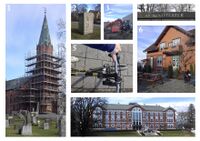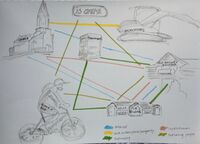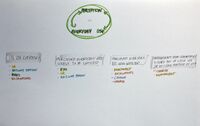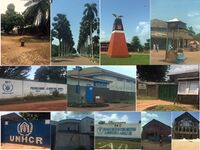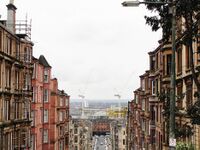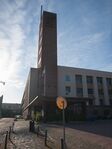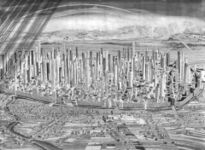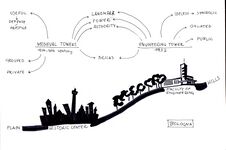LED Seminar 2016 - Landscape Symbols Reflection Group G
Landscape Symbol 1- Landscape Symbols Ås, Tonje Cecilie Stordalen
Representations and analytical drawings
in addition to your initial visual please add two further analytical drawings of your symbol
Reflections
Landscape symbols
The landscape symbols I have chosen have come to exist for different reasons. Some of them are institutionally based (i.e. the church and the university building), and some are more related to the everyday life (bikes). Whilst both the church, the university building, the railway station and the cinema was built in order to meet a specific need, the monument was built to commemorate people who died in WWII. The bikes and excavators have emerged from a need for respectively transportation and development - two aspects closely related to the society and people's everyday lives.
I would argue that the meaning of all landscape symbols have undergone some form of change due to changes in the society, but some have undergone larger changes than others.The church, for instance, has through socio-political, economic and cultural changes shifted from symbolizing power, political order and economic prosperity to merely having a historical and religious meaning today. In the 17th century most of the settlements in Ås was located close to the church, thus proving the church as a previous power structure. The church as a symbol is meaningful across cultures.
The railroad station (built in 1878-79) created an alternative connection between Ås and Oslo, making it possible for people who didn’t own their own transportation to visit the city. Establishments of various trade and service industries followed quickly shifting the village center gradually from Korsegården west of the church to the area around the station east of the church. The station building was a symbol of prosperity, economic growth and cultural changes. Today the station has a historical value and is a signature building in downtown Ås, representing the pride in Ås as a rural community. As a symbol the station may not be of substantial meaning to anyone who does not know the history of Ås.
The Ur-building was completed in 1905 and symbolizes the start of university. It represents not only the university itself, but its symbolic value is also strongly linked to Norway's history and culture. It was built from Swedish funds during the Swedish-Norwegian union and was meant to demonstrate the power Swedish had over Norwegians. Through social-political changes the building shifted from representing the battle of power between the two countries to representing knowledge and development. Most people, regardless of culture, find the building beautiful, but in order to understand the symbol one needs to know the history. A landscape symbol where the meaning has not changed noteworthy is the WWII-monument. Intentionally it was to commemorate the ones who died during the war, a purpose it still serves today. However, economic growth and general community development has made the monument less important today. As a symbol it is understandable across cultures.
The bike as a landscape symbol is negotiable, but I would argue that it is important for Ås because they are the No.1 way of getting around. Almost all residents own a bike, and once the snow disappears, both the center and NMBU Campus is filled with parked bicycles. To me, it stands for freedom of choice - it can take me practically anywhere and it is understandable in all cultures.
Landscape Symbol 2- Democratic Republic of the Congo, Sharla Russell
Representations and analytical drawings
in addition to your initial visual please add two further analytical drawings of your symbol
- GroupI slide2.JPG
slide 2
- GroupI slide3.JPG
slide 3
Reflections
Please write a 250 words text reflecting on the following questions, you can also take ideas from your group members into account
- How and why did the symbols you identify appear in your landscape?
- Did their meaning change along with socio-political, economic, environmental or cultural changes in your region, or country?
- What do these symbols mean to you today? Are they meaningful to more than just one cultural group? Are they shared across cultures?
add your text here
Landscape Symbol 3- Glasgow Tenements, Amber Roberts
Representations and analytical drawings
in addition to your initial visual please add two further analytical drawings of your symbol
- GroupI slide2.JPG
slide 2
- GroupI slide3.JPG
slide 3
Reflections
Glasgow's Tenements
The class-neutral tenements of Glasgow symbolise the ideals of Scottish socialism, standing in stark contrast to the strict class delineations of England's housing typology. As a new resident in Scotland I am keen to explore this point of difference in the 'everyday landscape' of Glasgow and its permutations through the tenement street that foregoes traditional centralised urban form and hierarchical street types, instead following a rigid and decentralised grid-iron pattern. Throughout the past century the tenements have become synonymous with Glasgow while the initial ideals they represented changed repeatedly through associations with rebellion and protest. At the same time the tenements continue to form the backdrop to the daily lives of the majority of the city's residents throughout the social classes.
How and why the symbols appeared in the landscape
The tenements of Glasgow were largely built between 1850 and 1900 to house the city's growing population. They enveloped the city centre and grew outwards into the surrounding districts and hills following a strict grid formation that makes overt their origination as planned neighbourhoods. Along with the grid pattern, strict rules governed the height and proportions of the buildings in relation to the streets upon which they stood - as such no tenement building could exceed in height the width of the street, ensuring natural light was able to reach each street, while giving Glasgow a distinctive low rise yet high density aesthetic. Each block had a decoratively tiled communal 'close' (or central hallway) through which to access the residencies inside, a communal garden with a courtyard type layout walled on each side by the tenements, a clothes drying area and refuse space. These elements created a distinctive built layout and urban form while encouraging sociality and community spirit between residents and neighbours.
Everyone is Equal But Some Are More Equal Than Others While the tenements presented a class neutral ideology, social hierarchies were formed and displayed through various means. (-to add photographs). While the working class tenements were formed of singular roomed flats, the scale of comfort and adequacy increased along social ranks. As such, the tenements ranged from single rooms up to mansion sized flats overlooking private greens and parklands. Class was also made visible from the street level through the decoration of the communal 'close', the size of front doors, the presence of front gardens and stairs leading up to the entrances, and the architectural style of the facade (the wealthiest replicating Georgian/ 18th Century English styles and materials).
How meanings have changed -to complete Slums/ Bomb Damage/ Govan Riots/ Working Class image/ Retaliation against traditional styles
What the tenements mean today -to complete Tenement House - Museum / 'Everyday Landscape'/ Home/ Human scale environment/ Trendy/
Landscape Symbol 4-7000 Eichen Kassel, Linda Rehn
Representations and analytical drawings
in addition to your initial visual please add two further analytical drawings of your symbol
- GroupI slide2.JPG
slide 2
- GroupI slide3.JPG
slide 3
Reflections
The basalt stone can be found next to a tree,usually an oak. Overall the city were 7000 Oaks for each basalt stone planted. This ensemble is titled “7000 Oaks - urban forestation instead of city administration”, and is a landscape art work of the artist Joseph Beuys. 1982, at the start the documenta 7, Beuys put 7000 basalt columns as a wedge-shaped delta on the Friedrichsplatz in front of the Fridericianum in Kassel which is a major place and building. At its peak, Beuys planted the first oak next to their associated basalt stone. The basalt plastic acts according to Beuys as an indicator of progress. The more trees have been planted in Kassel, the smaller the plastic. "Not building, not dismantling, but both at the same function". Everyone who donated $ 500, was allowed to remove a block of basalt and for planting elsewhere an oak tree, which then the respective block of stone was delivered. In 1987, the extensive project documentation was completed. The project was an extensive artistic and ecological intervention with the aim of changing the urban environment sustainably in terms of overall urbanization. The initially controversial project has evolved into a townscape part of the public space of the city of Kassel, and witness the "expanded concept of art" developed by Joseph Beuys. The as "social sculpture" marked artwork engages sustainable in the topographical and social structure of the city, it also committed to active care and kept alive in this way. In Kassel in 1993 also the club founded "7000 Oaks", who has made the protection and care of trees to the task. About the effects Rhea Thönges-Stringaris (Kassel) wrotes: There is hardly anyone in Kassel who met Beuys trees in Avenue rows or squares. We have become accustomed to them. They are part of our daily life and at the same time components of an unusual, because ultimately invisible sculpture. No one can ever see as a whole. A sculpture in the traditional sense, without outlines, is unthinkable. But outlines of the 7000 Oaks are not even tangible on paper or on a map. The landscape architect John Steiner in Stuttgart gathered the fruit of the oaks, put them in flower pots and outputs the resulting growing plants (project Eichenfeldstraße - Getting younger generation). Olaf-Axel Burow and the project group Future Moderation Kassel University initiated in 2002 under the Kassler Application for European Capital of Culture a project with the motto 7000 characters in terms of Beuys Social Sculpture. The action should raise awarness about the aesthetic deep structure of the city of Kassel . On 16 March 2012, the 30th anniversary of the 7000 Oaks was celebrated and consecrated in honor of the artist Joseph Beuys a street was named after him in Kassel. This was the reason, there to add another unit of tree and stone. The Dia Center for the Arts planted in 1988 five trees, each with a basalt stone, in New York. In 1996 the work was extended with 18 new trees was. One oak basalt column was planted in the park of the government district of Düsseldorf.
Landscape Symbol 6 - Engineering Tower - Guido Maria Amorati
Representations and analytical drawings
in addition to your initial visual please add two further analytical drawings of your symbol
Reflections
Please write a 250 words text reflecting on the following questions, you can also take ideas from your group members into account
- How and why did the symbols you identify appear in your landscape?
- Did their meaning change along with socio-political, economic, environmental or cultural changes in your region, or country?
- What do these symbols mean to you today? Are they meaningful to more than just one cultural group? Are they shared across cultures?
I chose as landscape symbol the tower of the Faculty of Engineering of the University of Bologna (Slide 1). It appears to me every day as I go to study, so the choice may seem pretty trivial, but I think that might lead to interesting reflections. The first aspect concerns the intrinsic value of the architectural work. Designed by Giuseppe Vaccaro and built in the 1937 during the fascist regime, it is a very significant example of Italian Rationalism, an architectural current, probably the most important in the modern era in Italy, connected with the Modern Movement. This building is placed on a small hill just outside of the historic center of Bologna and respects the canons of functionalism, except for the element of the tower which has a great symbolic meaning. Used as book storage, not so practical indeed, it answers to the regime will of power and authority, but at the same time, also for the use of material, is strongly related to the image of the city. Bologna in medieval times had a very large number of tower construction. Between the 12th and 13th centuries the number of towers erected in the city was very large in the maximum flowering time, there were up to 100 (Slide 2), today 24 have survived. It is believed that the richest families in the period of struggle for investitures pro-imperial, pro-papal, used them as an instrument of aggression-defense and a symbol of power. Anyway the lack of a family dominating on the others brought to a proliferation of this kind of construction. This is an example of how the political situation could affect the shape of the city: the same phenomenon could not have happened in a city with a different political order. So I think that is very interesting to see how this building, despite of his modern style, is linked to the historical city.
Landscape Symbol 5- State Square Bahman Nahri
Representations and analytical drawings
in addition to your initial visual please add two further analytical drawings of your symbol
- GroupI slide2.JPG
slide 2
- GroupI slide3.JPG
slide 3
Reflections
I have selected this square as a symbol, because It is one of the key stones of the city and it can be counted as the place that for one century all the important things happened there. The name of the square represents the importance of it, State square shows that it was collecting all the forces of the time together to make a re-union of all of them together.
This historical square shows an important period of urbanization in north-western part of Iran, there are three unique and well build buildings in three sides of the square that gives an eagle shape in plan to this part of the city, but unfortunately in western part stand the new built Ministry of justice, that it has any relationship with other parts of square. Municipality stands at the eastern wing, and in southern and northern wings stands respectively military organization and police headquarters, but recently the cultural heritage organization had recently moved to police headquarters building. These buildings were built in 1930, and in 1940 it was attacked by allies, and afterwards it was used as a collecting point of soldiers in revolution, and of course so many historical coincidences. And as far as I remember all the addresses all the ways and all the memories somehow end up here to this square.
Group reflection
Please add a summary of your group reflection here
